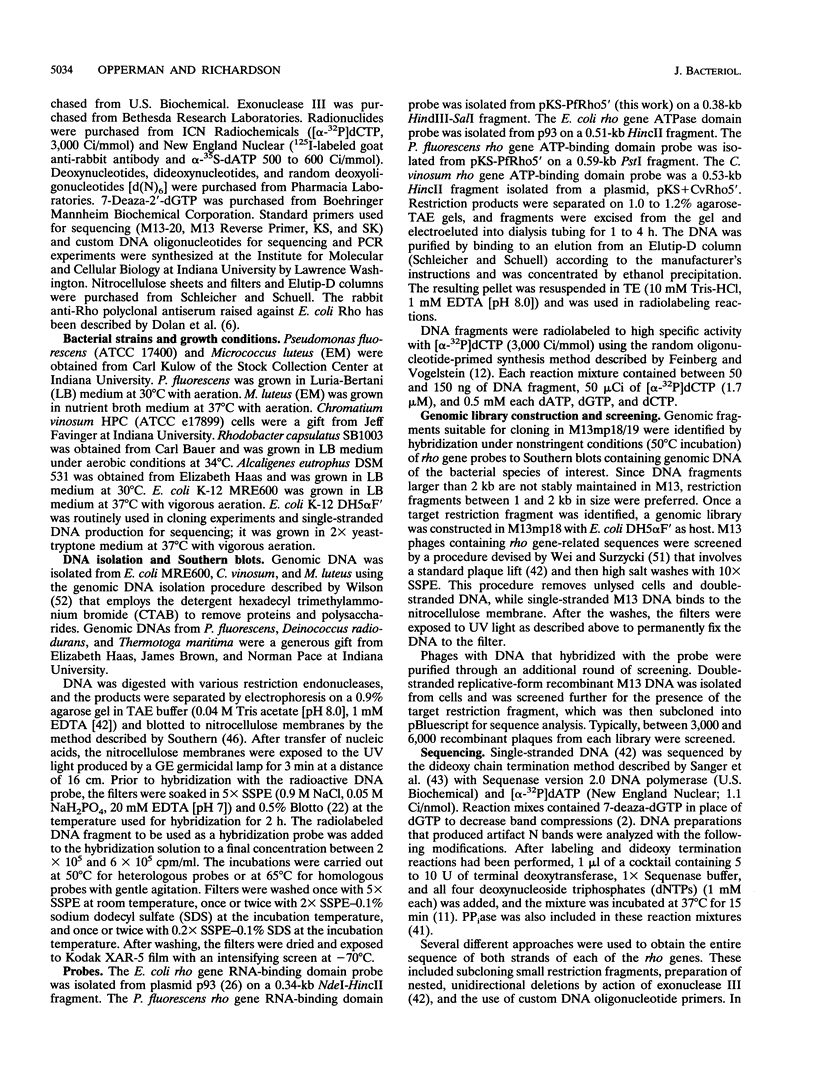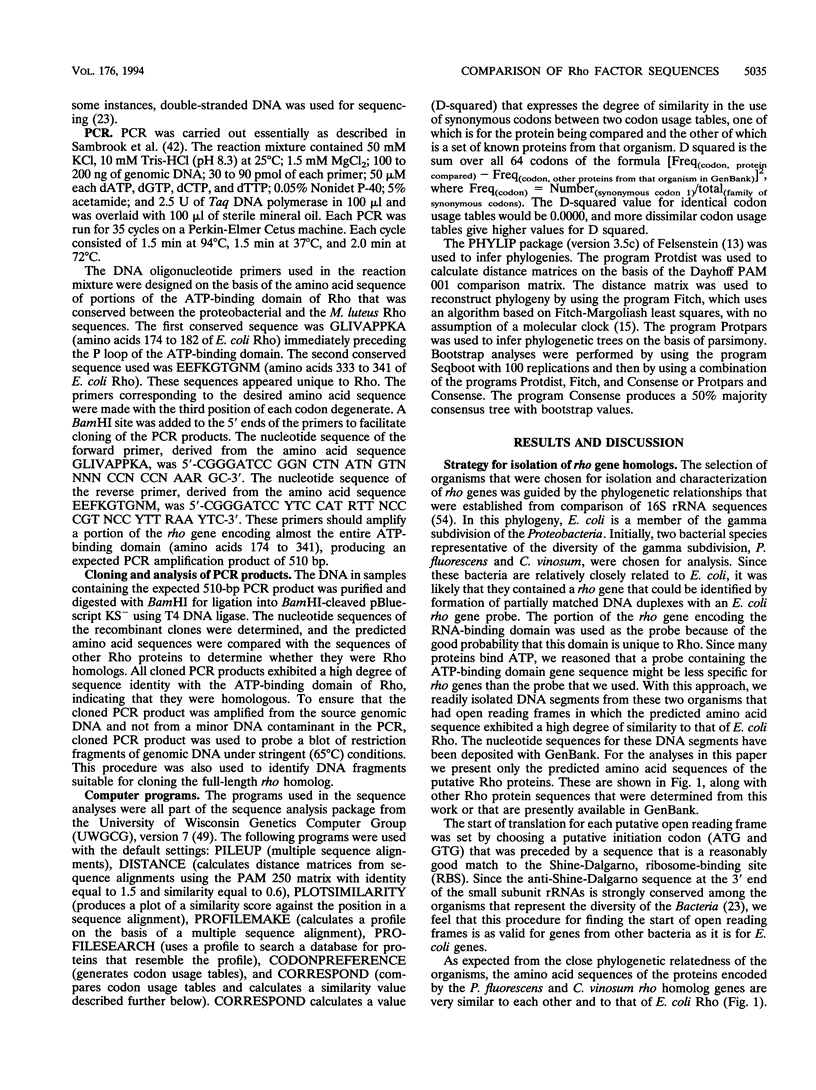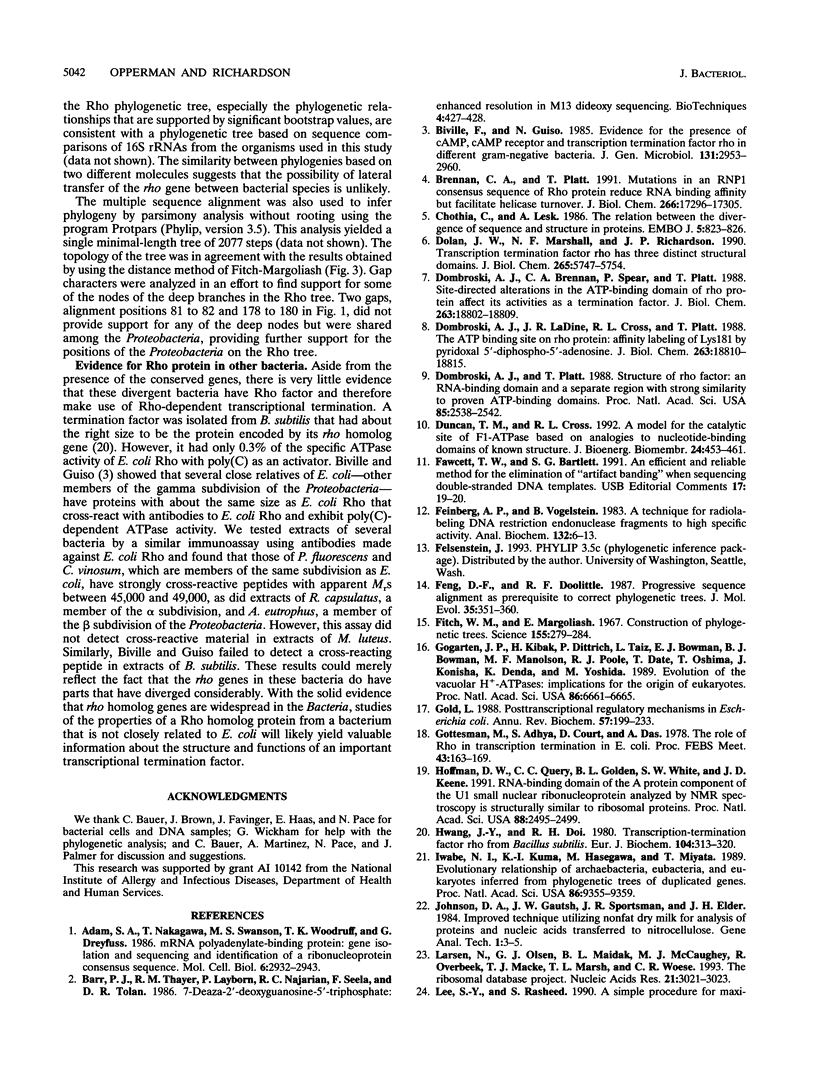Abstract
Genes from Pseudomonas fluorescens, Chromatium vinosum, Micrococcus luteus, Deinococcus radiodurans, and Thermotoga maritima with homology to the Escherichia coli rho gene were cloned and sequenced, and their sequences were compared with other available sequences. The species for all of the compared sequences are members of five bacterial phyla, including Thermotogales, the most deeply diverged phylum. This suggests that a rho-like gene is ubiquitous in the Bacteria and was present in their common ancestor. The comparative analysis revealed that the Rho homologs are highly conserved, exhibiting a minimum identity of 50% of their amino acid residues in pairwise comparisons. The ATP-binding domain had a particularly high degree of conservation, consisting of some blocks with sequences of residues that are very similar to segments of the alpha and beta subunits of F1-ATPase and of other blocks with sequences that are unique to Rho. The RNA-binding domain is more diverged than the ATP-binding domain. However, one of its most highly conserved segments includes a RNP1-like sequence, which is known to be involved in RNA binding. Overall, the degree of similarity is lowest in the first 50 residues (the first half of the RNA-binding domain), in the putative connector region between the RNA-binding and the ATP-binding domains, and in the last 50 residues of the polypeptide. Since functionally defective mutants for E. coli Rho exist in all three of these segments, they represent important parts of Rho that have undergone adaptive evolution.
Full text
PDF










Selected References
These references are in PubMed. This may not be the complete list of references from this article.
- Adam S. A., Nakagawa T., Swanson M. S., Woodruff T. K., Dreyfuss G. mRNA polyadenylate-binding protein: gene isolation and sequencing and identification of a ribonucleoprotein consensus sequence. Mol Cell Biol. 1986 Aug;6(8):2932–2943. doi: 10.1128/mcb.6.8.2932. [DOI] [PMC free article] [PubMed] [Google Scholar]
- Biville F., Guiso N. Evidence for the presence of cAMP, cAMP receptor and transcription termination factor rho in different gram-negative bacteria. J Gen Microbiol. 1985 Nov;131(11):2953–2960. doi: 10.1099/00221287-131-11-2953. [DOI] [PubMed] [Google Scholar]
- Brennan C. A., Platt T. Mutations in an RNP1 consensus sequence of Rho protein reduce RNA binding affinity but facilitate helicase turnover. J Biol Chem. 1991 Sep 15;266(26):17296–17305. [PubMed] [Google Scholar]
- Chothia C., Lesk A. M. The relation between the divergence of sequence and structure in proteins. EMBO J. 1986 Apr;5(4):823–826. doi: 10.1002/j.1460-2075.1986.tb04288.x. [DOI] [PMC free article] [PubMed] [Google Scholar]
- Dolan J. W., Marshall N. F., Richardson J. P. Transcription termination factor rho has three distinct structural domains. J Biol Chem. 1990 Apr 5;265(10):5747–5754. [PubMed] [Google Scholar]
- Dombroski A. J., Brennan C. A., Spear P., Platt T. Site-directed alterations in the ATP-binding domain of rho protein affect its activities as a termination factor. J Biol Chem. 1988 Dec 15;263(35):18802–18809. [PubMed] [Google Scholar]
- Dombroski A. J., LaDine J. R., Cross R. L., Platt T. The ATP binding site on rho protein. Affinity labeling of Lys181 by pyridoxal 5'-diphospho-5'-adenosine. J Biol Chem. 1988 Dec 15;263(35):18810–18815. [PubMed] [Google Scholar]
- Dombroski A. J., Platt T. Structure of rho factor: an RNA-binding domain and a separate region with strong similarity to proven ATP-binding domains. Proc Natl Acad Sci U S A. 1988 Apr;85(8):2538–2542. doi: 10.1073/pnas.85.8.2538. [DOI] [PMC free article] [PubMed] [Google Scholar]
- Duncan T. M., Cross R. L. A model for the catalytic site of F1-ATPase based on analogies to nucleotide-binding domains of known structure. J Bioenerg Biomembr. 1992 Oct;24(5):453–461. doi: 10.1007/BF00762362. [DOI] [PubMed] [Google Scholar]
- Feinberg A. P., Vogelstein B. A technique for radiolabeling DNA restriction endonuclease fragments to high specific activity. Anal Biochem. 1983 Jul 1;132(1):6–13. doi: 10.1016/0003-2697(83)90418-9. [DOI] [PubMed] [Google Scholar]
- Feng D. F., Doolittle R. F. Progressive sequence alignment as a prerequisite to correct phylogenetic trees. J Mol Evol. 1987;25(4):351–360. doi: 10.1007/BF02603120. [DOI] [PubMed] [Google Scholar]
- Fitch W. M., Margoliash E. Construction of phylogenetic trees. Science. 1967 Jan 20;155(3760):279–284. doi: 10.1126/science.155.3760.279. [DOI] [PubMed] [Google Scholar]
- Gogarten J. P., Kibak H., Dittrich P., Taiz L., Bowman E. J., Bowman B. J., Manolson M. F., Poole R. J., Date T., Oshima T. Evolution of the vacuolar H+-ATPase: implications for the origin of eukaryotes. Proc Natl Acad Sci U S A. 1989 Sep;86(17):6661–6665. doi: 10.1073/pnas.86.17.6661. [DOI] [PMC free article] [PubMed] [Google Scholar]
- Gold L. Posttranscriptional regulatory mechanisms in Escherichia coli. Annu Rev Biochem. 1988;57:199–233. doi: 10.1146/annurev.bi.57.070188.001215. [DOI] [PubMed] [Google Scholar]
- Hoffman D. W., Query C. C., Golden B. L., White S. W., Keene J. D. RNA-binding domain of the A protein component of the U1 small nuclear ribonucleoprotein analyzed by NMR spectroscopy is structurally similar to ribosomal proteins. Proc Natl Acad Sci U S A. 1991 Mar 15;88(6):2495–2499. doi: 10.1073/pnas.88.6.2495. [DOI] [PMC free article] [PubMed] [Google Scholar]
- Hwang J. Y., Doi R. H. Transcription-termination factor Rho from Bacills subtilis. Eur J Biochem. 1980 Feb;104(1):313–320. doi: 10.1111/j.1432-1033.1980.tb04430.x. [DOI] [PubMed] [Google Scholar]
- Iwabe N., Kuma K., Hasegawa M., Osawa S., Miyata T. Evolutionary relationship of archaebacteria, eubacteria, and eukaryotes inferred from phylogenetic trees of duplicated genes. Proc Natl Acad Sci U S A. 1989 Dec;86(23):9355–9359. doi: 10.1073/pnas.86.23.9355. [DOI] [PMC free article] [PubMed] [Google Scholar]
- Larsen N., Olsen G. J., Maidak B. L., McCaughey M. J., Overbeek R., Macke T. J., Marsh T. L., Woese C. R. The ribosomal database project. Nucleic Acids Res. 1993 Jul 1;21(13):3021–3023. doi: 10.1093/nar/21.13.3021. [DOI] [PMC free article] [PubMed] [Google Scholar]
- Lee S. Y., Rasheed S. A simple procedure for maximum yield of high-quality plasmid DNA. Biotechniques. 1990 Dec;9(6):676–679. [PubMed] [Google Scholar]
- Linder P., Lasko P. F., Ashburner M., Leroy P., Nielsen P. J., Nishi K., Schnier J., Slonimski P. P. Birth of the D-E-A-D box. Nature. 1989 Jan 12;337(6203):121–122. doi: 10.1038/337121a0. [DOI] [PubMed] [Google Scholar]
- Miloso M., Limauro D., Alifano P., Rivellini F., Lavitola A., Gulletta E., Bruni C. B. Characterization of the rho genes of Neisseria gonorrhoeae and Salmonella typhimurium. J Bacteriol. 1993 Dec;175(24):8030–8037. doi: 10.1128/jb.175.24.8030-8037.1993. [DOI] [PMC free article] [PubMed] [Google Scholar]
- Nagai K., Oubridge C., Jessen T. H., Li J., Evans P. R. Crystal structure of the RNA-binding domain of the U1 small nuclear ribonucleoprotein A. Nature. 1990 Dec 6;348(6301):515–520. doi: 10.1038/348515a0. [DOI] [PubMed] [Google Scholar]
- Nehrke K. W., Seifried S. E., Platt T. Overproduced rho factor from p39AS has lysine replacing glutamic acid at residue 155 in the linker region between its RNA and ATP binding domains. Nucleic Acids Res. 1992 Nov 25;20(22):6107–6107. doi: 10.1093/nar/20.22.6107. [DOI] [PMC free article] [PubMed] [Google Scholar]
- O I., Stitt B. L. 8-Azido-ATP inactivation of Escherichia coli transcription termination factor Rho. Modification of one subunit inactivates the hexamer. J Biol Chem. 1994 Feb 18;269(7):5009–5015. [PubMed] [Google Scholar]
- Ohama T., Muto A., Osawa S. Spectinomycin operon of Micrococcus luteus: evolutionary implications of organization and novel codon usage. J Mol Evol. 1989 Nov;29(5):381–395. doi: 10.1007/BF02602908. [DOI] [PubMed] [Google Scholar]
- Pinkham J. L., Platt T. The nucleotide sequence of the rho gene of E. coli K-12. Nucleic Acids Res. 1983 Jun 11;11(11):3531–3545. doi: 10.1093/nar/11.11.3531. [DOI] [PMC free article] [PubMed] [Google Scholar]
- Query C. C., Bentley R. C., Keene J. D. A common RNA recognition motif identified within a defined U1 RNA binding domain of the 70K U1 snRNP protein. Cell. 1989 Apr 7;57(1):89–101. doi: 10.1016/0092-8674(89)90175-x. [DOI] [PubMed] [Google Scholar]
- Quirk P. G., Dunkley E. A., Jr, Lee P., Krulwich T. A. Identification of a putative Bacillus subtilis rho gene. J Bacteriol. 1993 Feb;175(3):647–654. doi: 10.1128/jb.175.3.647-654.1993. [DOI] [PMC free article] [PubMed] [Google Scholar]
- Richardson J. P. Transcription termination. Crit Rev Biochem Mol Biol. 1993;28(1):1–30. doi: 10.3109/10409239309082571. [DOI] [PubMed] [Google Scholar]
- Richardson L. V., Richardson J. P. A vector for controlled, high-yield production of specifically mutated proteins in Escherichia coli: test of a putative cytidine-binding domain in Rho factor and its Thr16----Ala mutant. Gene. 1992 Sep 1;118(1):103–107. doi: 10.1016/0378-1119(92)90255-n. [DOI] [PubMed] [Google Scholar]
- Sanger F., Nicklen S., Coulson A. R. DNA sequencing with chain-terminating inhibitors. Proc Natl Acad Sci U S A. 1977 Dec;74(12):5463–5467. doi: 10.1073/pnas.74.12.5463. [DOI] [PMC free article] [PubMed] [Google Scholar]
- Saraste M., Sibbald P. R., Wittinghofer A. The P-loop--a common motif in ATP- and GTP-binding proteins. Trends Biochem Sci. 1990 Nov;15(11):430–434. doi: 10.1016/0968-0004(90)90281-f. [DOI] [PubMed] [Google Scholar]
- Schmid S. R., Linder P. D-E-A-D protein family of putative RNA helicases. Mol Microbiol. 1992 Feb;6(3):283–291. doi: 10.1111/j.1365-2958.1992.tb01470.x. [DOI] [PubMed] [Google Scholar]
- Southern E. M. Detection of specific sequences among DNA fragments separated by gel electrophoresis. J Mol Biol. 1975 Nov 5;98(3):503–517. doi: 10.1016/s0022-2836(75)80083-0. [DOI] [PubMed] [Google Scholar]
- Tilly K., Campbell J. A Borrelia burgdorferi homolog of the Escherichia coli rho gene. Nucleic Acids Res. 1993 Feb 25;21(4):1040–1040. doi: 10.1093/nar/21.4.1040. [DOI] [PMC free article] [PubMed] [Google Scholar]
- Tsurushita N., Shigesada K., Imai M. Mutant rho factors with increased transcription termination activities. I. Functional correlations of the primary and secondary polynucleotide binding sites with the efficiency and site-selectivity of rho-dependent termination. J Mol Biol. 1989 Nov 5;210(1):23–37. doi: 10.1016/0022-2836(89)90288-x. [DOI] [PubMed] [Google Scholar]
- Walker J. E., Saraste M., Runswick M. J., Gay N. J. Distantly related sequences in the alpha- and beta-subunits of ATP synthase, myosin, kinases and other ATP-requiring enzymes and a common nucleotide binding fold. EMBO J. 1982;1(8):945–951. doi: 10.1002/j.1460-2075.1982.tb01276.x. [DOI] [PMC free article] [PubMed] [Google Scholar]
- Wei Y. G., Surzycki S. J. Screening recombinant clones containing sequences homologous to Escherichia coli genes using single-stranded bacteriophage vector. Gene. 1986;48(2-3):251–256. doi: 10.1016/0378-1119(86)90083-1. [DOI] [PubMed] [Google Scholar]
- Wittekind M., Görlach M., Friedrichs M., Dreyfuss G., Mueller L. 1H, 13C, and 15N NMR assignments and global folding pattern of the RNA-binding domain of the human hnRNP C proteins. Biochemistry. 1992 Jul 14;31(27):6254–6265. doi: 10.1021/bi00142a013. [DOI] [PubMed] [Google Scholar]
- Woese C. R. Bacterial evolution. Microbiol Rev. 1987 Jun;51(2):221–271. doi: 10.1128/mr.51.2.221-271.1987. [DOI] [PMC free article] [PubMed] [Google Scholar]


